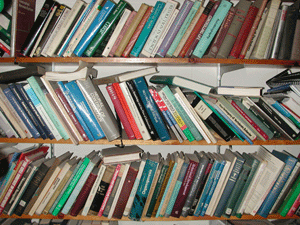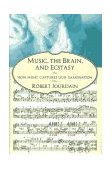Serendip is an independent site partnering with faculty at multiple colleges and universities around the world. Happy exploring!
Music, the Brain, and Ecstasy: How Music Captures Our Imagination

|
Serendip's Bookshelves |
 Robert Jourdain, Music, the Brain, and Ecstasy: How Music Captures Our Imagination, William Morrow Press, 1997 Robert Jourdain, Music, the Brain, and Ecstasy: How Music Captures Our Imagination, William Morrow Press, 1997
Commentary by Amber Baum, Bryn Mawr 1998. Amber wrote this review during her senior year as a Biology major and Neural and Behavioral Sciences concentrator and is continuing her education as a doctoral student in neuroscience. |
This book's title is dead-on accurate. By constructing a framework for understanding music from the wave up (the first four chapters cover sound, tone, melody, and harmony, for example), Jourdain explains music's underlying structure and reviews the physics and neuroscience needed to understand current research in musicology. As a music novice, I greatly appreciated his clear, entertaining and erudite explanations of music theory and history; as a biologist and neuroscientist, his sections on anatomy and neurology were the ideal size, presenting just enough information to engage any reader, but avoiding, as few popular scientific texts do, the traps of over- and under-explanation. Jourdain's experience as a science writer is evident (this is his sixth book on science and technology) and I'm pretty confident that one trained in music would be as uniquely and equally satisfied with his presentation of the topic as I am with his presentation of "my" discipline.
The overwhelming quality of the book is balance. Jourdain is careful to balance his musical and scientific explanations of phenomena, his hard data with informative and amusing quotes and anecdotes from the literature, and his verbal explanations with carefully chosen diagrams. The chapter "...to composition..." illustrates: it begins, as all of the chapters do, with a revealing anecdote from musical history, using it to illustrate a musical concept (in this case, that of the prodigy) which it then analyzes from the appropriate scientific angle (the demographics, psychology and neuroanatomy of savant syndrome). He then draws on an aspect of the scientific analysis and finds more musicological examples of it (e.g. auditory imagery and musical memory as features of the prodigy), which he describes first with primary sources (diaries and letters about composers and their style), and then explains with other sources (modern musicological assessments and neuroscience's take on the possible mechanisms of auditory imagery). The combination of the two different analytical styles is seamless. A novice in either area would be pleased, and the more widely read in either area have no problem in finding their own examples and explanations to further expand on the reading itself.
Jourdain is sparing with graphics; but when necessary he uses a brain outline or a bar of music to great effect. I was refreshed by his uncluttered brain outlines, which appropriately serve only to show the position of various cortical areas, and as a non-musician I was thankful for his use of one small piece of music, Henry Mancini's hummably famous Pink Panther theme, to illustrate points at every stage of complexity. (the choice seemed atypical at first, but as Jourdain develops the musical ideas in each chapter with the same eight bars of music, the genius of the composer and the author became clear to me.) Some other sections in the composer chapter are titled "Composers' brains" and "composer IQ", the score", "composing at a piano", "working methods", and "the composer's personality"; providing a truly varied sampling of topics that do indeed cover "composition" without leaving the reader cheated at learning too little or overextended from learning too much.
I was recommending this book to lovers of science and music alike before I had even reached the end, but when I finally did I found that my recommendations had been too narrow. The last chapter, "...to ecstacy", came somewhat as a surprise for its expansion on the theme of the book (the third movement, if you will :), and its existence makes this book recommended reading to all who are curious about the human experience of pleasure. Jourdain starts with an excellent point: human life and desires can be seen as ruled by pleasure's pursuit, but there is very little literature on what pleasure actually is and on how it is experienced! He goes on then to deal seriously with this subject with a perspicacity that I did not expect to find, even from an author whose depth of thought and planning had been impressing me for over 200 pages already. In the last chapters Jourdain makes a good case against music as a language to make a case for the experience of music as a sort of external system for creating emotional experiences in the body, drawing on the work of Antonio Damasio to assert that that which is emotional is not by definition illogical but pre-logical.
I have weakly attempted in one sentence what the book takes 333 pages to say (and has a glossary to explain, a delightful few pages where the reader can giggle at the novelty of seeing progressions like "sitar...somatosensory cortex...synapse....syncopation...tempo...temporal lobe"), so please don't think that my explanation has even scratched th e surface of the pointst this book makes throughout. At first Jourdain's title seems like typical popular science writing grandiosity, but the book itself turns out to be a surprisingly complex work (the jacket reveals Jourdain as a pianist and composer as well as a writer) that has precisely fulfilled its duty. (To completely do so is not an option, of course: Jourdain is quite careful to curb optimism about neuropsychiatric research methods and to qualify the validity of and separate musical and general intelligence from IQ, caveats required in today's popularizations of research but not made dull by overstatement here; it is as if Jourdain assumes that his readers know all about the ambiguities of measures like IQ and PET scans and he just wants to remind them so he can rest easy in not explaining all the background).
I recommend this book to anyone who is at all intrigued by the title. While those interested _only_ in ecstasy may be a bit bored during the first 9 chapters (From sound...to tone...to melody...to harmony...to rhythm...to composition....to performance...to listening...to understanding...), students and potential students of the brain and/or music will find themselves with an enhanced understanding of both upon its completion.
Some relevant web windows:
- MuSICA, the Music and Science Information Computer Archive, Norman Weinberger, University of California, Irvine
- TCAMS - Timing, Concentration, and Motor Skills .... "this www site is being developed as a non-commercial communication link for teaching and training professionals in the fields of education, therapy, rehabilitation, neural sciences, social work, sports, music, dance and theater"



Comments
Ecstasy
A thoroughly delightful book. Nice mixture of science and the art of music. Much better than a couple of other books with similar subjects. Every musician and teacher can probably learn something new from this book.
Nice review!
The review made by Mr. Amber Baum, it´s just perfect. I am ordering the book right now after his comments.
Thanks him I found was I was looking for,
Greetings,
Miguel Reyes